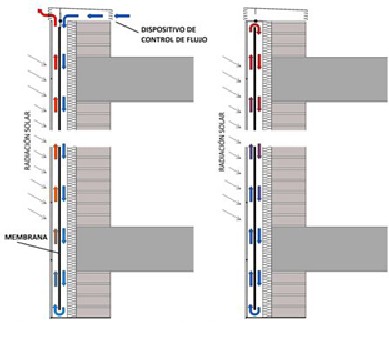Nov
15
New Building Façade Enhances Energy Efficiency
November 15, 2017 | 7 Comments
Two researchers from School of Building Engineering at UPM have developed a ventilated façade with a double chamber and flow control device that significantly saves energy in buildings. This sustainable and efficient solution can be applied in both rehabilitation works and new buildings due to its simplicity of implementation.
The team’s work has been published in the Energy and Buildings journal and has also been patented.
The façade is the main constructive element of a building that allows us to meet the requirements of energy efficiency and interior comfort established in the national and international rules and directives of the construction sector. The type of system, the design and the right execution of the façade itself are critical aspects that determine the final energy consumption of the building.

Graphic of the façade functioning in summer (left) and winter (right). Image Credit: Jaime Santa Cruz and César Porras. Click image for the largest view.
Today, the air flow expenses are of 40% – 65% of the total expenses of a building. Buildings in a Mediterranean-continental climate like in Spain suffer in winter energy losses through their north and east façades due to low temperatures. Likewise, these buildings in summer obtain energy gains through their south and west façades due to solar radiation. In both cases, the air flow is needed in the building in order to maintain suitable inner conditions for their inhabitants, counteracting the energy gains-losses through the building envelope.
In order to improve the energy efficiency of façades, two researchers from the group of Tecnología Edificatoria y Medio Ambiente (TEMA) at UPM have developed a new system of ventilated façade. Today, the conventional ventilated façades are composed of an inner sheet, thermal insulation, ventilation chamber and exterior finish.
The new façade design adds a second air chamber between the existing one and the façade insulation, both chambers are interconnected by the bottom of the façade. Another feature is a new element at the top to regulate the air flow in the chambers, depending on the gradient of the existing temperature between inside and outside the building.
A ventilated façade with a double chamber presents two improvements over the conventional system. Firstly, energy gains-losses are reduced through the façades reducing, on consequence, the energy consumption due to air flow. Secondly, the design of the system helps to reduce the vertical temperature gradient along the envelope, homogenizing the air temperature in the chambers throughout the year.
By minimizing the vertical thermal gradients, global consumption due to energy gains-losses through the façade depends less on the height of the building, preventing the upper levels to present higher or lower indoor comfort and degree of energy efficiency than the lower levels. Beside that, this system is a sustainable and efficient solution that can be applied in both rehabilitation works and new buildings due to its simplicity of implementation.
The initial over cost can be short-term amortized when considering the remarkable energy savings of this design.
The authors of this work said, “this research work highlights the potential energy efficiency of buildings through the redesign of conventional construction systems.”
Building façades or even busy home entryways or foyers all need some attention to air loss. This team’s work is welcome indeed and we hope that the patent doesn’t stand as a barrier to widespread adoption.
Comments
7 Comments so far


Building façades or even busy home entryways or foyers all need some attention to air loss..
The initial over cost can be short-term amortized when considering the remarkable energy savings of this design.
Today, the conventional ventilated façades are composed of an inner sheet, thermal insulation, ventilation chamber and exterior finish.
The new façade design adds a second air chamber between the existing one and the façade insulation, both chambers are interconnected by the bottom of the façade.
Likewise, these buildings in summer obtain energy gains through their south and west façades due to solar radiation.
The initial over cost can be short-term amortized when considering the remarkable energy savings of this design.
I know little about the building design. After reading the post, I learn more about it. Thanks for your sharing.